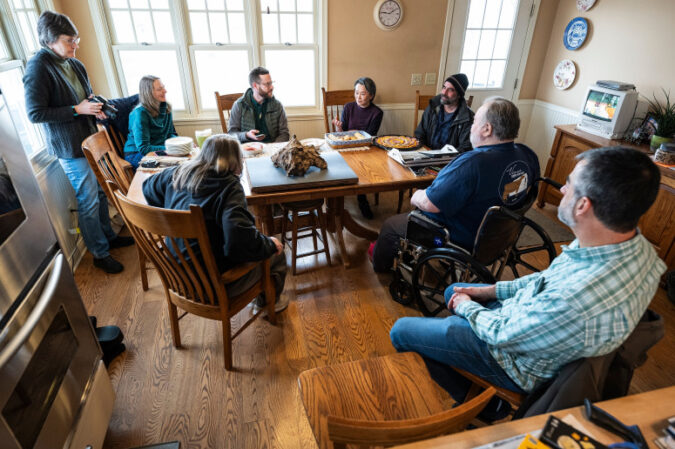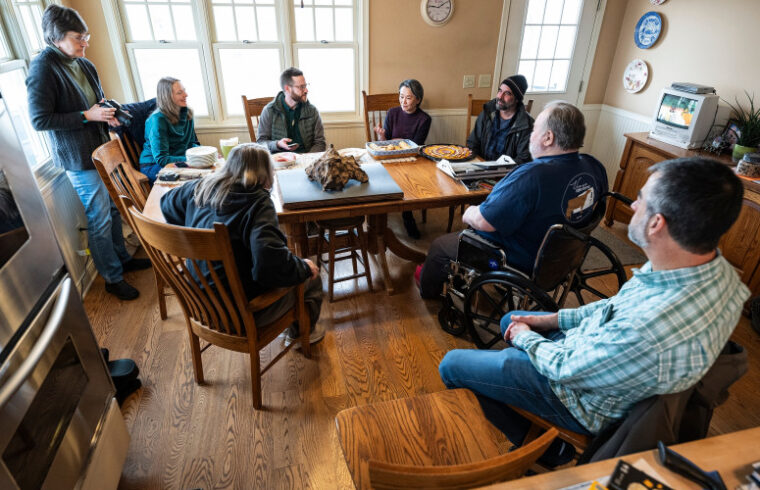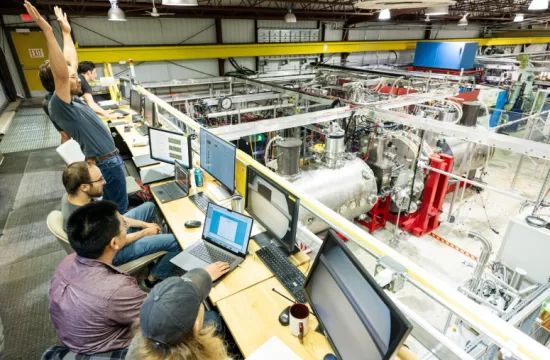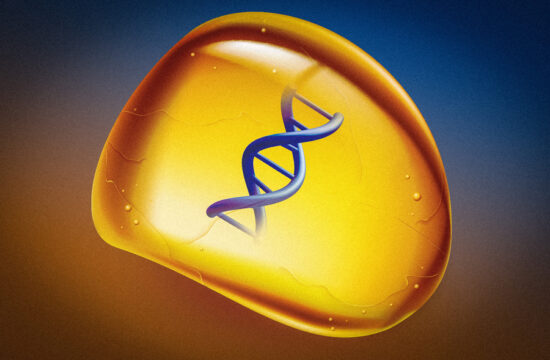
VIENNA, WIS. – It was a balmy spring day in May 2009 when Jim Koch’s plow kicked up an unusually hefty rock.
Koch was prepping a field for alfalfa on his farm in the Town of Vienna just a short drive north of Madison. At first, he didn’t notice the rock. But after stopping the plow and taking to the field by foot to pick stones out of the freshly tilled soil, Koch noticed a knobby one poking through the dirt. When he bent to grab it, Koch immediately sensed that something about the rock was distinct.
“I’m thinking, ‘this is quite heavy,'” says Koch. “It was uniquely different and caught my attention.”
Turns out, Koch had just discovered a meteorite, and not just any space rock: It’s the largest iron meteorite classified in the United States since 1981. The hunk of iron weighs in at nearly 110 pounds, is Wisconsin’s 15th classified meteorite, and is the first ever recorded in Dane County.
Even more exciting, the meteorite still carries scars from its fiery entry through Earth’s atmosphere — rare features for an iron meteorite. Those marks set on the ancient rock’s surface just before it crashed with a thud on what would one day become Vienna EqHo Farm, where Koch and his wife, Jan Shepel, raise dairy cattle and horses.
Fifteen years after making their discovery, Koch and Shepel are now sharing their find with the public after agreeing to sell the meteorite at a price significantly below its market value to the University of Wisconsin Geology Museum.
The meteorite will go on temporary display beginning April 6, coinciding with the Geology Museum’s open house during the annual UW Science Expeditions and, this year, the university’s 175th anniversary community open house.
The agreement between Koch and Shepel and the museum represents a generous donation by the couple, who could have sold it to a dealer for a much higher price, and several other museum supporters who funded the purchase. It will allow the museum’s 60,000 annual visitors to get up close with a unique piece of Wisconsin’s natural history, just a dozen miles from where it was discovered.
“We’re so excited to welcome this incredible find to our collection,” says Carrie Eaton, curator of the UW Geology Museum. “This meteorite will excite and intrigue thousands of people every year, from school-aged visitors to UW students and the general public. It’s a special thing to get to share with our visitors a piece of the early solar system that came to rest right here in our neighborhood.”
The Vienna Meteorite, as it’s provisionally called according to the longstanding convention that meteorites be named for the place where they’re found, will eventually have its own permanent exhibit in the museum, Eaton says. That will involve building a new display case because the meteorite is so large it can’t squeeze into the museum’s current meteorite case.
While the meteorite’s size and proximity to Madison are compelling, Eaton says it’s the rare features on its surface that make the rock such an exciting museum specimen.
These features include flow lines, which are tiny ridges formed by molten iron that rippled across the meteor’s surface as it heated up to tremendous temperatures while hurtling through Earth’s thick atmosphere.
“You can also see where little droplets that melted off part of the meteor actually hit the meteor again and left little splatter marks,” Eatons says. “That’s really cool.”
Collectively, these features make up what’s called the meteorite’s “fusion crust,” and they show the meteor’s orientation as it dropped from the sky.
Intact fusion crusts are rarely found on iron meteorites that aren’t freshly fallen, Eaton says. That’s because the iron surface weathers quickly on Earth, essentially rusting away.
“That means it hasn’t been on Earth that long,” she says. “We’re looking at perhaps in the neighborhood of a few hundred years.”
Eaton and her colleagues have been working on getting the meteorite classified, a process that involves detailed scientific analyses that undergo review just like any peer-reviewed research. The team includes Museum Director Rich Slaughter and Noriko Kita, a distinguished scientist and meteorite expert from UW–Madison, along with Jim Holstein and Philipp Heck at the Chicago Field Museum. (Heck is a former UW–Madison postdoctoral researcher.) Assuming no hiccups in the process, once it’s officially classified, the meteorite will be known scientifically by its Vienna name.
While the drive from Vienna EqHo Farm to UW–Madison is short, the path the Vienna Meteorite took to the museum was a long and winding one.
Koch and Shepel suspected early on that what they had was a meteorite. Those suspicions were further fueled when Shepel’s sister, Laurie Shepel, and brother-in-law, Joe Zanter, got a peek at it. A metallurgical engineer and UW–Madison alumnus, Zanter sawed off a small piece of the rock for analysis, which confirmed the group’s suspicions that the rock had a non-terrestrial origin.
However, a case of poor timing meant the meteorite wouldn’t get official recognition for years.
“We tried to find somebody that was interested in it,” says Jan Shepel. “We sent a lot of emails everywhere.”
Eventually, Zanter sent the small sample he took to the Chicago Field Museum, which officially confirmed it as a meteorite. But still, the rock sat for years in an outbuilding on Vienna EqHo Farm, protected under a pile of old carpeting as the four wondered why no one seemed as excited about it as they were.
Finally, in 2023, Koch decided to contact the UW Geology Museum. Eaton, Slaughter and Kita paid the farm a visit and were immediately thrilled about the find.
“It was just really fun for us to have someone finally get excited about it,” says Shepel. “We had it sitting here all these years and were like, ‘Why isn’t anyone else as excited about this as we are?'”
Koch and Shepel knew then that they wanted the meteorite to go to the museum. That meant it would stay in one piece and remain nearby in a place with an educational mission. It also meant they and anyone else could visit and enjoy it at any time for free.
“I just think about all the stones in those fields I’ve picked up before this, and to come across this one is just mind-blowing,” says Koch. “I’m just so happy to see it there at UW.”








